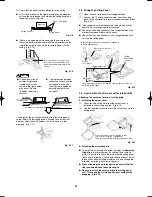
40
8-2. Evacuation
Be sure to use a vacuum pump that includes a function for
prevention of back-flow, in order to prevent back-flow of pump
oil into the unit tubing when the pump is stopped.
●
Perform vacuuming of the indoor unit and tubing.
Connect the vacuum pump to the gas tube valve and apply
vacuum at a pressure –101kPa (–755 mmHg, 5 Torr) or
below.
Continue vacuum application for a minimum of 1 hour after
the pressure reaches –101kPa (–755 mmHg, 5 Torr).
(1) Attach the charge hose end described in the preceding
steps to the vacuum pump to evacuate the tubing and
indoor unit. Confirm that the “Lo” knob of the manifold
valve is open. Then, run the vacuum pump.
(2) When the desired vacuum is reached, close the “Lo”
knob of the manifold valve and turn off the vacuum pump.
Confirm that the gauge pressure is under –101 kPa (–755
mmHg, 5 Torr) after 4 to 5 minutes of vacuum pump
operation. (Fig. 8-4)
CAUTION
Use a cylinder specifically designed for use with R410A.
Lo
Hi
Manifold valve
Pressure
gauge
Vacuum pump
Open
Close
Gas tube
Liquid tube
Outdoor unit
Close
Fig. 8-4
8-3. Charging Additional Refrigerant
●
Charging additional refrigerant (calculated from the liquid
tube length as shown in “Amount of additional refrigerant
charge”) using the liquid tube service valve. (Fig. 8-5)
●
Use a balance to measure the refrigerant accurately.
●
If the additional refrigerant charge amount cannot be
charged at once, charge the remaining refrigerant in liquid
form by using the gas tube service valve with the system in
Cooling mode at the time of test run. (Fig. 8-6)
* If an additional refrigerant charge has been performed, list the
refrigerant tubing length and amount of additional refrigerant
charge on the product label (inside the panel).
Lo
Hi
R410A
Manifold valve
Pressure
gauge
Valve
Close
Close
Gas tube
Liquid tube
Outdoor unit
Close
Liquid
Fig. 8-5
Open
Open
Gas tube
Liquid tube
Outdoor unit
Open
Fig. 8-6
8-4. Finishing the Job
(1) With a hex wrench, turn the liquid tube service valve stem
counterclockwise to fully open the valve.
(2) Turn the gas tube service valve stem counterclockwise to
fully open the valve.
CAUTION
To avoid gas from leaking when removing the charge hose,
make sure the stem of the gas tube is turned all the way
out (“BACK SEAT”) position.
(3) Loosen the charge hose connected to the gas tube service
port (7.94 mm) slightly to release the pressure, and then
remove the hose.
(4) Replace the 7.94 mm flare nut and its bonnet on the gas
tube service port and fasten the flare nut securely with an
adjustable wrench or box wrench. This process is very
important to prevent gas from leaking from the system.
(5) Replace the valve caps at both gas and liquid service
valves and fasten them securely.
Airwell̲PAC-i̲eng.indb 40
Airwell̲PAC-i̲eng.indb 40
2009/07/09 16:13:31
2009/07/09 16:13:31
Содержание OU-PSINV-25HR
Страница 75: ...75 ...
















































